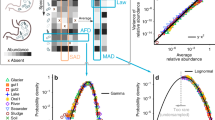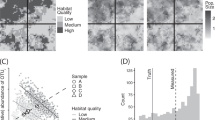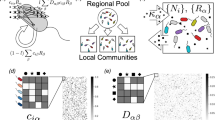Abstract
Microorganisms are the most abundant, diverse and functionally important organisms on Earth. Over the past decade, microbial ecologists have produced the largest ever community datasets. However, these data are rarely used to uncover law-like patterns of commonness and rarity, test theories of biodiversity, or explore unifying explanations for the structure of microbial communities. Using a global scale compilation of >20,000 samples from environmental, engineered and host-related ecosystems, we test the power of competing theories to predict distributions of microbial abundance and diversity–abundance scaling laws. We show that these patterns are best explained by the synergistic interaction of stochastic processes that are captured by lognormal dynamics. We demonstrate that lognormal dynamics have predictive power across scales of abundance, a criterion that is essential to biodiversity theory. By understanding the multiplicative and stochastic nature of ecological processes, scientists can better understand the structure and dynamics of Earth’s largest and most diverse ecological systems.
This is a preview of subscription content, access via your institution
Access options
Access Nature and 54 other Nature Portfolio journals
Get Nature+, our best-value online-access subscription
$29.99 / 30 days
cancel any time
Subscribe to this journal
Receive 12 digital issues and online access to articles
$119.00 per year
only $9.92 per issue
Buy this article
- Purchase on Springer Link
- Instant access to full article PDF
Prices may be subject to local taxes which are calculated during checkout




Similar content being viewed by others
References
Brown, J. H., Mehlman, D. W. & Stevens, G. C. Spatial variation in abundance. Ecology 76, 1371–1382 (1995).
Hubbell, S. P. The Unified Neutral Theory of Biodiversity and Biogeography (Princeton Univ. Press, 2001).
McGill, B. J. Towards a unification of unified theories of biodiversity. Ecol. Lett. 13, 627–642 (2010).
Harte, J. Maximum Entropy and Ecology: A Theory of Abundance, Distribution, and Energetics (Oxford Univ. Press, 2011).
Locey, K. J. & Lennon, J. T. Scaling laws predict global microbial diversity. Proc. Natl Acad. Sci. USA 113, 5970–5975 (2016).
Sogin, M. L. et al. Microbial diversity in the deep sea and the underexplored “rare biosphere.” Proc. Natl Acad. Sci. USA 103, 12115–12120 (2006).
Lynch, M. D. J. & Neufeld, J. D. Ecology and exploration of the rare biosphere. Nat. Rev. Microbiol. 13, 217–229 (2015).
Reid, A. & Buckley, M. The Rare Biosphere: A Report from the American Academy of Microbiology (American Academy of Microbiology, 2011).
McGill, B. J. et al. Species abundance distributions: moving beyond single prediction theories to integration within an ecological framework. Ecol. Lett. 10, 995–1015 (2007).
Horner-Devine, M. C., Lage, M., Hughes, J. B. & Bohannan, B. J. M. A taxa–area relationship for bacteria. Nature 432, 750–753 (2004).
Putnam, R. Community Ecology (Chapman & Hall, 1993).
MacArthur, R. On the relative abundance of species. Am. Nat. 94, 25–36 (1960).
Sih, A., Englund, G. & Wooster, D. Emergent impacts of multiple predators on prey. Trends Ecol. Evol. 13, 350–355 (1998).
Dunbar, J., Barns, S. M., Ticknor, L. O. & Kuske, C. R. Empirical and theoretical bacterial diversity in four Arizona soils. Appl. Environ. Microbiol. 68, 3035–3045 (2002).
Curtis, T. P., Sloan, W. T. & Scannell, J. W. Estimating prokaryotic diversity and its limits. Proc. Natl Acad. Sci. USA 99, 10494–10499 (2002).
Bohannan, B. J. M. & Hughes, J. New approaches to analyzing microbial biodiversity data. Curr. Opin. Microbiol. 6, 282–287 (2003).
Schloss, P. D. & Handelsman, J. Status of the microbial census. Microbiol. Mol. Biol. Rev. 68, 686–691 (2004).
Pedrós-Alió, C. & Manrubia, S. The vast unknown microbial biosphere. Proc. Natl Acad. Sci. USA 113, 6585–6587 (2016).
Fisher, R. A., Corbet, A. S. & Williams, C. B. The relation between the number of species and the number of individuals in a random sample of an animal population. J. Anim. Ecol. 12, 42–58 (1943).
Jaynes, E. T. Probability Theory: The Logic of Science (Cambridge Univ. Press, 2003).
White, E. P., Thibault, K. M. & Xiao, X. Characterizing species abundance distributions across taxa and ecosystems using a simple maximum entropy model. Ecology 93, 1772–1778 (2012).
Baldridge, E., Harris, D. J, Xiao, X. & White E. P. An extensive comparison of species-abundance distribution models. PeerJ 4, e2823 (2016).
McGill, B. Strong and weak tests of macroecological theory. Oikos 102, 679–685 (2003).
Ulrich, W., Ollik, M. & Ugland, K. I. A meta-analysis of species-abundance distributions. Oikos 119, 1149–1155 (2010).
Locey, K. J. & White, E. P. How species richness and total abundance constrain the distribution of abundance. Ecol. Lett. 16, 1177–1185 (2013).
Fierer, N. & Lennon, J. T. The generation and maintenance of diversity in microbial communities. Am. J. Bot. 98, 439–448 (2011).
Allen, A. P., Li, B. & Charnov, E. L. Population fluctuations, power laws and mixtures of lognormal distributions. Ecol. Lett. 4, 1–3 (2001).
Harte, J. & Newman, E. Maximum information entropy: a foundation for ecological theory. Trends Ecol. Evol. 29, 384–389 (2014).
Gilbert, J. A., Jansson, J. K. & Knight, R. The Earth microbiome project: successes and aspirations. BMC Biol. 12, 69 (2014).
Turnbaugh, P. J. et al. The human microbiome project. Nature 449, 804–810 (2007).
Meyer, F. et al. The metagenomics RAST server—a public resource for the automatic phylo- genetic and functional analysis of metagenomes. BMC Bioinformatics 9, 386 (2008).
Flores, G. E. et al. Microbial community structure of hydrothermal deposits from geochemically different vent fields along the Mid-Atlantic Ridge. Environ. Microbiol. 13, 2158–2171 (2011).
Wang, J. et al. Phylogenetic beta diversity in bacterial assemblages across ecosystems: deterministic versus stochastic processes. ISME J. 7, 1310–1321 (2013).
Chu, H. et al. Soil bacterial diversity in the Arctic is not fundamentally different from that found in other biomes. Environ. Microbiol. 12, 2998–3006 (2010).
Fierer, N. et al. Comparative metagenomic, phylogenetic and physiological analyses of soil microbial communities across nitrogen gradients. ISME J. 6, 1007–1017 (2012).
Yatsunenko, T. et al. Human gut microbiome viewed across age and geography. Nature 486, 222–227 (2012).
Amend, A. S., Seifert, K. A., Samson, R. & Bruns, T. D. Indoor fungal composition is geographically patterned and more diverse in temperate zones than in the tropics. Proc. Natl Acad. Sci. USA 107, 13748–13753 (2010).
Gans, J. Computational improvements reveal great bacterial diversity and high metal toxicity in soil. Science 309, 1387–1390 (2005).
Dumbrell, A. J., Nelson, M., Helgason, T., Dytham, C. & Fitter, A. H. Relative roles of niche and neutral processes in structuring a soil microbial community. ISME J. 4, 337–345 (2010).
Magurran, A. E. & McGill, B. J. Biological Diversity Frontiers in Measurement and Assessment (Oxford Univ. Press, 2011).
Williamson, M. & Gaston, K. J. The lognormal distribution is not an appropriate null hypothesis for the species-abundance distribution. J. Anim. Ecol. 74, 409–422 (2005).
Harte, J., Zillio, T., Conlisk, E. & Smith, A. B. Maximum entropy and the state-variable approach to macroecology. Ecology 89, 2700–2711 (2008).
Cohen, J. E. Alternate derivations of a species-abundance relation. Am. Nat. 102, 165–172 (1968).
Heip, C. H. R., Herman, P. M. J. & Soetaert, K. Indices of diversity and evenness. Oceanis 24, 61–87 (1998).
Zipf, G. K. Human Behavior and the Principle of Least Effort (Addison-Wesley, 1949).
Newman, M. E. J. Power laws, Pareto distributions and Zipf’s law. Contemp. Phys. 46, 323–351 (2005).
Xiao, X., McGlinn, D. J. & White, E. P. A strong test of the maximum entropy theory of ecology. Am. Nat. 185, 70–80 (2015).
Acknowledgements
We thank J. Gilbert and S. Gibbons for providing EMP data and guidance on using it. We also thank the researchers who collected, sequenced and provided metagenomic data on MG-RAST, as well as the individuals who maintain and provide the MG-RAST service. We also acknowledge the researchers who provided the open-source code for conducting some of our analyses. Finally, we thank the HMP Consortium for providing their data on the NIH’s publically accessible DACC server. This work was supported by a National Science Foundation Dimensions of Biodiversity Grant (no. 1442246 to J.T.L. and K.J.L.) and the US Army Research Office (W911NF-14-1-0411 to J.T.L.).
Author information
Authors and Affiliations
Contributions
W.R.S. and K.J.L. conceived, designed and performed the experiments, analysed the data and contributed materials/analysis tools. W.R.S., K.J.L. and J.T.L. wrote the paper.
Corresponding author
Ethics declarations
Competing interests
The authors declare no competing financial interests.
Supplementary information
Supplementary Information
Supplementary Figures 1–6, Supplementary Tables 1–6. (PDF 4995 kb)
Rights and permissions
About this article
Cite this article
Shoemaker, W., Locey, K. & Lennon, J. A macroecological theory of microbial biodiversity. Nat Ecol Evol 1, 0107 (2017). https://doi.org/10.1038/s41559-017-0107
Received:
Accepted:
Published:
DOI: https://doi.org/10.1038/s41559-017-0107
This article is cited by
-
Response of Soil Microbial Communities and Nutrient Stoichiometry to Stand Age in Chinese Fir Plantations: Insights at the Aggregate Scale
Journal of Soil Science and Plant Nutrition (2024)
-
Plant-microbe interactions in the phyllosphere: facing challenges of the anthropocene
The ISME Journal (2022)
-
Macroecological distributions of gene variants highlight the functional organization of soil microbial systems
The ISME Journal (2022)
-
Gut microbiota plasticity in insular lizards under reversed island syndrome
Scientific Reports (2022)
-
Deep learning approaches for natural product discovery from plant endophytic microbiomes
Environmental Microbiome (2021)



